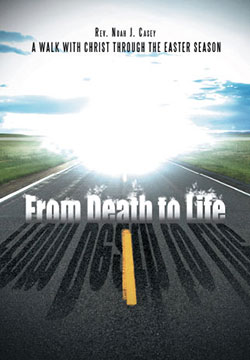Priest’s book serves as spiritual guide through Easter season
Reviewed by John Shaughnessy
 Father Noah Casey often views life with a touch of humor and an appreciation for the daily challenges and everyday wonders of the world.
Father Noah Casey often views life with a touch of humor and an appreciation for the daily challenges and everyday wonders of the world.
He also considers our spiritual lives as “a spiraling series of new beginnings.”
All those ingredients—flashes of humor, the search for God in the ordinary, and the potential for a fresh start spiritually—come together in Father Casey’s first book, From Death to Life: A Walk with Christ through the Easter Season.
So does his belief that the instructions for life from a fifth-century monk still have the power to change and deepen the faith of modern-day Christians.
“The uniqueness of this small volume lies in its foundation in the Rule of St. Benedict from the fifth century,” writes Father Casey, rector of SS. Peter and Paul Cathedral in Indianapolis. “Benedict found himself seeking a new path, a new way of life in response to the societal ills and decadence of his day.
“For Benedict, the instruments of good words in chapter 4 of the … Rule are intended to guide the monastic person into an ever-deepening life with God. These instruments have a timeless value and are just as helpful in the 21st century.”
Father Casey uses Benedict’s instruments as the foundation for 50 days of daily reflections that take the reader on a spiritual journey from Easter to Pentecost.
The journey also takes the reader on side trips that range from a monk’s cell to the parking lot of a Target store, from a visit to a grocery store with a young child to a procession to a cemetery to bury a great-aunt.
Each day and each stop provides a glimpse of the down-to-earth wisdom and the keep-your-eyes-on-God approach that has guided Father Casey during 37 years as a priest, including 30 years as a monk at Saint Meinrad Archabbey in St. Meinrad.
Consider these reflections from Father Casey’s book:
On how Christ’s resurrection should shape our lives to love God and our neighbor:
“As he did with his frightened disciples in those first days following the resurrection, he does now with us. Walking through the doors of our fears and apprehension, he continuously greets us with the words, ‘Peace be with you. Do not be afraid.’ If we find ourselves to be reluctant lovers, we have only to remember that we do not love alone. He who first loved us loves through us and we through, with and in Him. Herein lies our Paschal peace.”
On Benedict’s call to discipline your body, refrain from pampering yourself, and love fasting:
“Are we having fun yet? This ascetically unit of three injunctions has the appeal of standing neck-deep in mud on a July day in southern Indiana. How do these practices help us to celebrate the presence of Christ risen from the dead? We might look at it this way. The concept of ‘less is more’ is gaining some popularity in decorating. There is a thin line between tastefully decorated and cluttered. What the spiritual life seeks to promote is ‘less is more’ both spiritually and physically.”
On Benedict’s advice to place your hope in God alone:
“Placing one’s hope in God alone is always more challenging and even sometimes painful when we are, in fact, alone. When a spouse stands alone at the open coffin after the others have left, staring down into the mortal remains of a partner suddenly taken away; when you stand alone in a conviction about justice and peace and know the opposition and ridicule of everyone else around you; when you sit alone in your car having just left the doctor’s office, where you were informed of a terminal illness … in those moments, trusting alone in God is hard.
“At some point, faith demands that I alone place my hand in the hand of Christ, the faithful companion. We must invite him into our aloneness.”
On Benedict’s call to live by God’s commandments every day:
“Living by God’s commandments every day, while sounding like a spiritual sound bite, helps in staying focused on God. The commandments of love of God and neighbor keep calling us to return to the practice of loving and its centrality in our receiving and responding to the gift of discipleship. Loving gives us a focus that guides, comments on, and illuminates the various fragments of our lives.”
That call to love God and love our neighbor is a continuing theme that runs through Father Casey’s spiritual guide. That call connects to a defining question that Father Casey hopes his readers will seek to answer: What will bring me closer to God?
“Conversion is not a matter of becoming someone else,” Father Casey writes. “Deep, spiritual conversion is a matter of discovering, accepting and becoming the person God has made us to be in the first place. God spends our lifetime trying to convince us of our innate goodness.”
(To order From Death to Life in a hardcover, paperback or e-book version, contact Xlibris Corp. by phone at 1-888-795-4274 or visit the website www.Xlibris.com.) †
 Father Noah Casey often views life with a touch of humor and an appreciation for the daily challenges and everyday wonders of the world.
Father Noah Casey often views life with a touch of humor and an appreciation for the daily challenges and everyday wonders of the world.